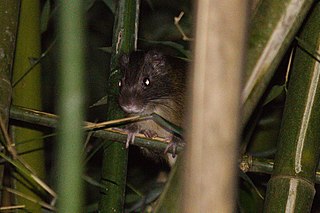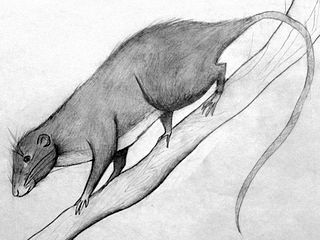
The rodent subfamily Rhizomyinae includes the Asian bamboo rats and certain of the African mole-rats. The subfamily is grouped with the Spalacinae and the Myospalacinae into a family of fossorial muroid rodents basal to the other Muroidea.

The bamboo rats are four species of rodents of the subfamily Rhizomyinae. They are the sole living representatives of the tribe Rhizomyini. These species are found in South Asia, Southeast Asia and East Asia.
The Giant Rat of Sumatra is a fictional giant rat, first mentioned by Arthur Conan Doyle in "The Adventure of the Sussex Vampire". As part of the tale, the protagonist, Sherlock Holmes, declares that there is a "story" connected with this rat, presumably a detective case he has handled. The name of the rat and its implied unpublished history were later used in works by many other writers.

The Spalacidae, or spalacids, are a family of rodents in the large and complex superfamily Muroidea. They are native to eastern Asia, the Horn of Africa, the Middle East, and southeastern Europe. It includes the blind mole-rats, bamboo rats, mole-rats, and zokors. This family represents the oldest split in the muroid superfamily, and comprises animals adapted to a subterranean way of life. These rodents were thought to have evolved adaptations to living underground independently until recent genetic studies demonstrated they form a monophyletic group. Members of the Spalacidae are often placed in the family Muridae along with all other members of the Muroidea.
The name giant rat has been applied to various species of large rats and may refer to:
The Bolivian bamboo rat, is a species of spiny rat from South America.

The Atlantic bamboo rat, or southern bamboo rat, is a spiny rat species found in humid tropical forests in Argentina, Brazil and Paraguay. It is the only member of the genus Kannabateomys.

Euryoryzomys emmonsae, also known as Emmons' rice rat or Emmons' oryzomys, is a rodent from the Amazon rainforest of Brazil in the genus Euryoryzomys of the family Cricetidae. Initially misidentified as E. macconnelli or E. nitidus, it was formally described in 1998. A rainforest species, it may be scansorial, climbing but also spending time on the ground. It lives only in a limited area south of the Amazon River in the state of Pará, a distribution that is apparently unique among the muroid rodents of the region.
Phyllomys is a genus of arboreal spiny rat, geographically restricted to the forests of eastern Brazil.

Dactylomys is the genus of South American bamboo rats They are arboreal members of the family Echimyidae.

Sody's tree rat is a rodent species in the family Muridae that has been recorded only in bamboo forest in Gunung Gede Pangrango National Park, West Java, Indonesia. It was first recorded during surveys carried out between 1933 and 1935 at an altitude of 1,000 m (3,300 ft). It is dark brown and has yellow to ochre spots. Its tail is uniform brown. Its head-to-body length ranges from 18 to 21 cm with a 27 to 30.5 cm long tail. Its long feet indicate that it is adapted to living in trees.

The lesser bamboo rat is a species of rodent in the family Spalacidae. It is monotypic within the genus Cannomys. It is found in Bangladesh, Bhutan, Cambodia, China, India, Myanmar, Nepal, and Thailand.
Makalata is a genus of rodents in the family Echimyidae.

The hoary bamboo rat is a species of rodent in the family Spalacidae found in Southeast Asia, East Asia (China) and South Asia (India).

The Chinese bamboo rat is a species of rodent in the family Spalacidae found in southern China, northern Myanmar, and northern Vietnam. Its habitat is bamboo thickets usually at high elevations, pine forests, and plantations.

The large bamboo rat, Sumatran rat, or Indomalayan rat is a species of rodent in the family Spalacidae found in Cambodia, China, Indonesia, Laos, Malaysia, Myanmar, Thailand, and Vietnam. It is one of four species of bamboo rat. Individuals can reach lengths of nearly 50 cm (20 in) with a 20 cm (7.9 in) tail, and weigh up to 4 kilograms (8.8 lb).

The Amazon bamboo rat is a species of spiny rat from the Amazon Basin of South America. It is also referred to as coro-coro, Toró, Rato-do-Bambú, or Rata del Bambú in different parts of its range. The bamboo rat prefers to reside in areas of dense vegetation, such as clumps of bamboo or in the canopy. It is an arboreal browser, consuming primarily leaves and spending much of its time off the ground. Because the Amazon bamboo rat spends most of its time in heavily forested areas, it is difficult to observe, and not much is known about its habits.











